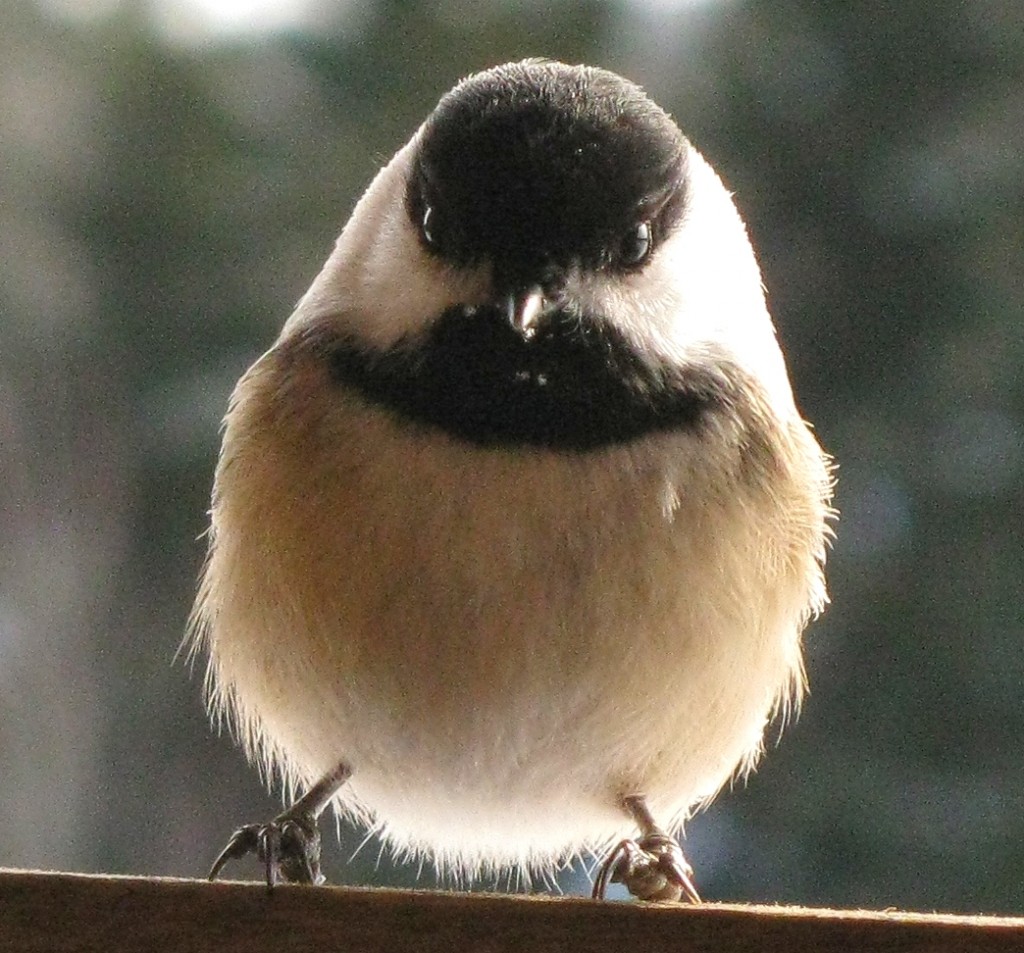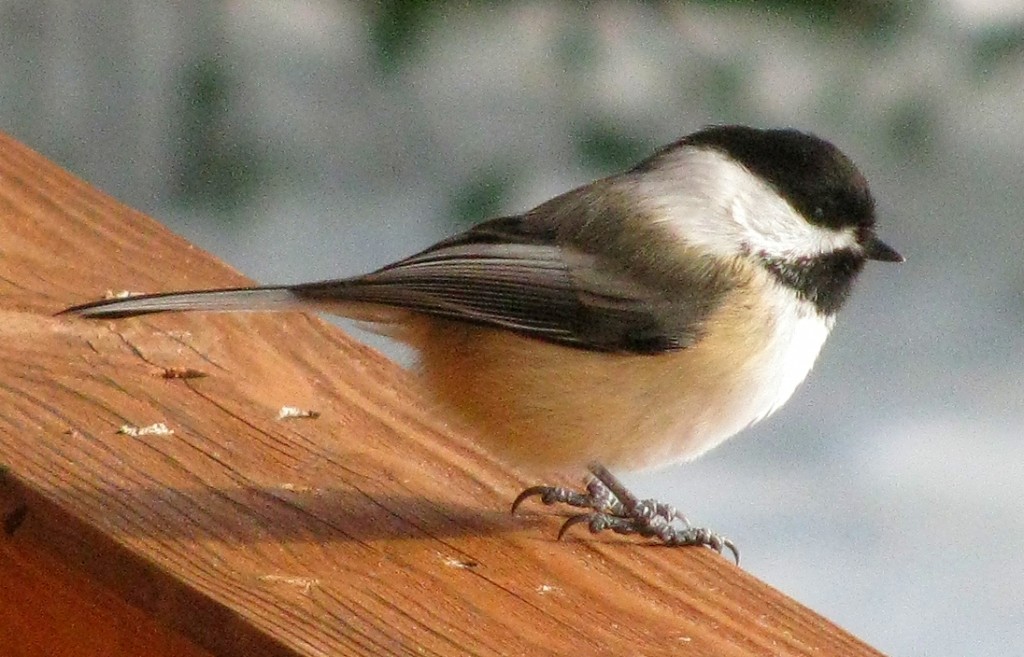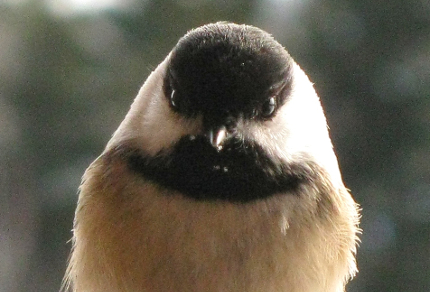
Black-capped Chickadee at Winter Feeder (© Magi Nams) Note Below Freezing Temperature
During Vilis’s and my year-long sojourn in Australia in 2010, I sometimes grew homesick for our home in Nova Scotia. At those times, surrounded by brilliantly-coloured parrots and lorikeets, I imagined a few black-capped chickadees flitting about in the eucalyptus trees. Now that I’ve returned to my home, each day brings visits of these diminutive songbirds to the feeder Vilis nailed to a porch pole in clear view from our kitchen. Perky and ever-curious, the black-caps fly their undulating flight patterns directly to the feeder from the shelter of spruce and pine windbreaks near our house. On their arrival at the feeder, they cling to the feeder roof or walls while scanning the area for danger. On determining that the coast is clear, they hop down onto the feeder platform and snatch up black oil sunflower seeds that appear larger than their tiny beaks, before winging back to the cover of the conifers.

Black-capped Chickadee in Feeder (© Magi Nams)

Black-capped Chickadee (© Magi Nams)
Black-capped chickadees, with their inquisitive and confiding personalities, are one of Canada’s best-known and best-loved avian species. Ranging across the country from the southern Yukon and Northwest Territories eastward to the Maritimes and the island of Newfoundland, they personify cheerfulness (‘Who ever saw a dejected Chickadee?’ wrote W. Earl Godfrey in The Birds of Canada) as they poke into tree and shrub bark crannies in search of insect eggs or harvest seeds from weeds or the feeders of indulgent humans. Traveling in small groups called ‘companies,’ black-caps forage in a variety of habitats that include deciduous and mixed forests, willow and alder thickets, forest clearings and edges, the trees of yards and parks, and occasionally, weedy fields.1
Even when out of sight, these year-round Canadian residents frequently divulge their presence with chuckling, brightly-vocalized ‘chicka-dee-dee-dee’ calls. In a month or so, we’ll also hear the chickadee’s whistled ‘fee-bee’ call1 as the spring mating season approaches. After mating, a pair of black-caps excavates or remodels a hole in a tree as a nesting site. The female lays her eggs within the cavity nest and roosts on them until they hatch, with the male feeding her while she incubates their developing offspring.2 Then both parents become caught up in the endless feeding forays necessary to procure food for their rapidly-growing young. During the summer of 2009, while collecting avian breeding evidence for the Maritime Breeding Bird Atlas, I heard muted but insistent cries of young birds emanating from somewhere. I also spotted a black-capped chickadee carrying what appeared to be an insect larva or caterpillar in its beak. The chickadee perched on a branch for several minutes, studying me. Having presumably decided that I was no threat, it flew to a snag in a shallow wetland and entered a round hole in the trunk of the dead tree. As it did so, the decibel level of the young birds’ cries rose. I’d stumbled across an active chickadee nest.
In A Sand County Almanac, the eminent American naturalist and conservation pioneer Aldo Leopold affectionately wrote of banded chickadee #65290, the only chickadee of the class of 1937 to survive five winters (‘Signs of genius were still lacking, but of his extraordinary capacity for living, there was now historical proof.’)3 While speculating as to why 65290 had outlived his classmates, Leopold questioned whether that particular bird was more adept at evading enemies; however, in the next breath, he wrote: ‘What enemies? A chickadee is almost too small to have any. That whimsical fellow called Evolution, having enlarged the dinosaur until he tripped over his own toes, tried shrinking the chickadee until he was just too big to be snapped up by flycatchers as an insect, and just too little to be pursued by hawks and owls as meat. Then he regarded his handiwork and laughed. Everyone laughs at so small a bundle of large enthusiasms.’4
Leopold added that ‘The sparrow hawk, the screech owl, the shrike, and especially the midget saw-whet owl might find it worth while to kill a chickadee’, but concluded that ‘It seems likely that weather is the only killer so devoid of both humor and dimension as to kill a chickadee. I suspect that in the chickadee Sunday School two mortal sins are taught: thou shalt not venture into windy places in winter, thou shalt not get wet before a blizzard.’4
Here in Nova Scotia, where winter temperatures bounce up and down like a yo-yo and wild storms periodically fling cold and freezing rain, as well as snow, onto the landscape, chickadees have to pay special attention to those Sunday School lessons. And they must watch for predators. Late this afternoon, in the dimming light before dusk, I heard a thud on the glass of the kitchen’s sliding doors and spotted a plump, round-headed bird – definitely an owl – flying away from the doors in a rather dazed fashion to the spruce windbreak, where it perched motionless on a branch. I hurried outdoors in my slippers, camera in hand, and managed to snap a back-view photo of the small raptor before it winged from the windbreak across an open field into spruce-peppered parkland.
Indoors, I studied the photo, flipping through my bird guides as I did so. My best guess is that the owl was a northern saw-whet owl, and that it was hunting my chickadees. Leopold included a corollary to his thoughts on winter and chickadees: ‘To the chickadee, winter wind is the boundary of the habitable world. If the chickadee had an office, the maxim over his desk would say: ‘Keep calm.”5 To this, I would add the old Scout motto: ‘Be prepared.’ For owls.

Black-capped Chickadee (© Magi Nams)
References:
1. W. Earl Godfrey. The Birds of Canada. 1979. National Museum of Natural Sciences, Ottawa, pp. 277-278.
2. Paul R. Ehrlich, David S. Dobkin, and Darryl Wheye. The Birder’s Handbook: A Field Guide to the Natural History of North American Birds. 1988. Simon and Schuster Inc., New York, p. 424.
3. Aldo Leopold. A Sand County Almanac. 1978 edition. Ballantyne Books, New York, pp. 94; 4. Ibid, p. 95-96; 5. Ibid, p. 97.


